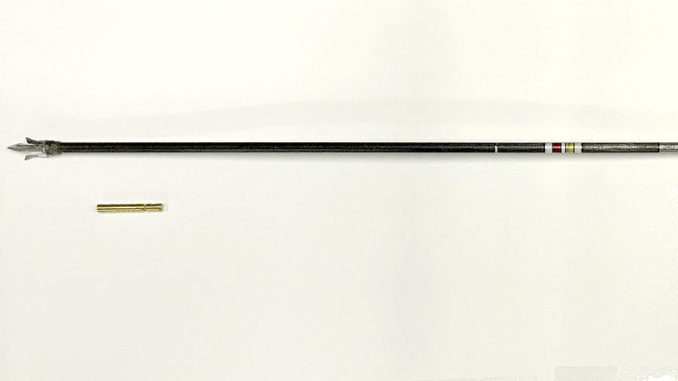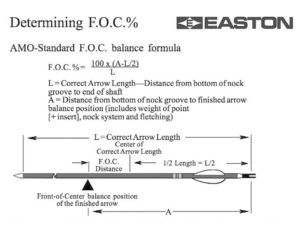
‘Front of Center’ measures how much of your arrow’s weight is in the broadhead end. It matters a great deal
Every sport has its trends, and the sport of bowhunting is no exception. The latest craze is shooting extreme “F.O.C.” arrows.
Log onto to any online archery forum, and you won’t have to scroll far to see a thread about it. Like most subjects on most forums, a lot of strongly opinionated people post, many of whom are not completely knowledgeable and a few who actually understand the topic well. It is important to be educated about the topic so you can read between the lines to glean helpful information without getting lost in opinions and pointless discussion.
F.O.C.
You might wonder “What is F.O.C., and why is it important?” F.O.C. is an abbreviation for “Front of Center,” which refers to the percentage of total arrow weight that is on the broadhead end of an arrow.

Having sufficient F.O.C. balance to any arrow is crucial to accuracy, but even more so when it comes to a broadhead-tipped hunting arrow. The best analogy for this is a badminton “birdie,” where the heavy tip pulls the lighter rear through the air. By having a higher F.O.C., your arrow becomes more accurate, especially at longer distances, and also gains momentum, helping to increase penetration on game animals.
During the bow-speed craze of the 1990s and early 2000s, many hunters mistakenly switched to lightweight broadheads in an effort to reduce the total weight of their arrows. The result was often a loss of accuracy due to the “tail wagging the dog” effect and also poor penetration. In my opinion, the pendulum is starting to swing too far the other way, as people are being led to shoot arrows that are excessively heavy in an effort to achieve extreme F.O.C. weights that are much higher than necessary.
Heavy F.O.C. is nothing new, having been around since the dawn of archery. Native Americans and other early archers used broadheads made of stone that were extremely heavy, on wooden shafts fletched with extremely light feathers. It is only recently with modern materials that archers have had the ability to shoot lighter tips, causing their F.O.C. to be too low.
Material changes
With the addition of plastic vanes and heavier, lighted arrow nocks — which add weight to the nock end of the arrow — thus reducing F.O.C., the problem was exacerbated. Only recently have many archers started to worry about proper F.O.C. due to better education on the subject. The longer shots that today’s equipment allows for has also increased the need for higher F.O.C. weights. This might lead you to think, “If a higher F.O.C. is good, a much higher F.O.C. should be even better!” Not necessarily; that thought process is a slippery slope that can lead to other issues.
Our society is always looking for the magic bullet or super pill that will instantly fix all of our problems. Extremely high F.O.C. has occupied that niche recently in the archery world. There are even people selling test kits with super-high F.O.C. online. Although it often helps correct poor arrow flight due to improper form or tuning, this correction comes at a cost. Extremely high F.O.C. weight leads to extremely heavy arrows, which drastically affect trajectory. Unless the archer has a range compensating sight, such as a Garmin Xero, Burris Oracle, or E-Z-V, this can result in missing shots due to a range misjudgment of only one or two yards.
Accuracy over penetration
I often hear people say, “I want to be able to penetrate both shoulders.” According to the Ashby Foundation, which has done extensive scientific research on the subject, arrow weights of at least 650 grains are required for consistent penetration when encountering large bone. But this will have the trajectory of a lead balloon out of most whitetail setups. One absolute is that you must hit the animal to penetrate it at all. Think about it this way: if you hit the dirt with a very heavy arrow, all you do is to penetrate deeper into the ground. Shot placement and proper target angle helps eliminate the shoulder as an obstacle on whitetails. Like most things in life, it is important to find a literal balance when it comes to F.O.C.
Easton Archery recommends an F.O.C. of 10% to 15% for hunting arrows. Anything over 15% is extreme, with 10% to 12% being ideal. F.O.C. for your arrow can easily be calculated using a thin edge — such as a butter knife blade, a pencil, a tape measure, and a calculator. Simply find the balance point of your arrow by laying it across the knife edge. Mark it with the pencil, and measure to it from the bottom of your arrow’s nock groove (where the string attaches). Next, measure the total length of your arrow from the bottom of the nock groove to the end of the shaft itself. Then, plug these numbers into the formula to calculate your arrow’s F.O.C.
Make adjustments
If your F.O.C. is too low, you can easily increase it by using heavier broadheads or weighted arrow inserts to add weight to the front of your arrow. F.O.C. can also be increased by removing lighted nocks and fletching your arrows with either smaller vanes or feathers to decrease the weight at the rear. My personal whitetail arrow weighs 475 grains — which is fairly heavy — with an 11% F.O.C. This will kill any whitetail in the world with proper shot placement. My Garmin Xero sight eliminates worry about trajectory costing me an animal.
Hopefully, this has helped explain F.O.C. and why it is important. Check your arrow’s F.O.C. and adjust it to get the most out of your setup this year. Do some research; keep an open mind, but be skeptical enough to verify the info in many forums. As always, if you have questions or need help, consult your local pro shop. Consider the source; when it comes to the subject of arrows, I would believe Easton Archery, the world’s oldest and largest arrow manufacturer, before a keyboard warrior in most cases. Increase your F.O.C. — but not too much — and watch your shooting improve.


